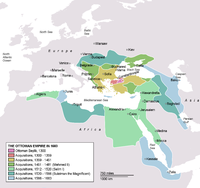
Peace of Amasya
Encyclopedia

Suleiman the Magnificent
Suleiman I was the tenth and longest-reigning Sultan of the Ottoman Empire, from 1520 to his death in 1566. He is known in the West as Suleiman the Magnificent and in the East, as "The Lawgiver" , for his complete reconstruction of the Ottoman legal system...
of the Ottoman Empire
Ottoman Empire
The Ottoman EmpireIt was usually referred to as the "Ottoman Empire", the "Turkish Empire", the "Ottoman Caliphate" or more commonly "Turkey" by its contemporaries...
at the city of Amasya
Amasya
- History :Its location in this steep valley makes the city a mountain stronghold, easy to defend, and thus Amasya has had a long and prominent history.-Antiquity:...
, following the Ottoman–Safavid War of 1532–1555
Ottoman–Safavid War (1532–1555)
The Ottoman–Safavid War of 1532–1555 was fought between the Ottoman Empire of Suleiman the Magnificent and the Persian Safavid Empire of Tahmasp I.-Background:...
.
The treaty defined the border between Iran and the Ottoman empire and was followed by twenty years of peace. By this treaty Armenia
Armenia
Armenia , officially the Republic of Armenia , is a landlocked mountainous country in the Caucasus region of Eurasia...
and Georgia
Georgia (country)
Georgia is a sovereign state in the Caucasus region of Eurasia. Located at the crossroads of Western Asia and Eastern Europe, it is bounded to the west by the Black Sea, to the north by Russia, to the southwest by Turkey, to the south by Armenia, and to the southeast by Azerbaijan. The capital of...
were divided equally between the two, the Ottoman Empire obtained most of Iraq
Iraq
Iraq ; officially the Republic of Iraq is a country in Western Asia spanning most of the northwestern end of the Zagros mountain range, the eastern part of the Syrian Desert and the northern part of the Arabian Desert....
, including Baghdad
Baghdad
Baghdad is the capital of Iraq, as well as the coterminous Baghdad Governorate. The population of Baghdad in 2011 is approximately 7,216,040...
, which gave them access to the Persian Gulf
Persian Gulf
The Persian Gulf, in Southwest Asia, is an extension of the Indian Ocean located between Iran and the Arabian Peninsula.The Persian Gulf was the focus of the 1980–1988 Iran-Iraq War, in which each side attacked the other's oil tankers...
, while the Persians retained their former capital Tabriz
Tabriz
Tabriz is the fourth largest city and one of the historical capitals of Iran and the capital of East Azerbaijan Province. Situated at an altitude of 1,350 meters at the junction of the Quri River and Aji River, it was the second largest city in Iran until the late 1960s, one of its former...
and the north-western borders as they were prior to the wars. The frontier thus established ran across the mountains
Likhi Range
Likhi Range or Surami Range is a mountain range in Georgia, a part of the Caucasus mountains. It connects the Greater Caucasus and Lesser Caucasus ranges....
dividing eastern and western Georgia (under native vassal princes), through Armenia, and via the western slopes of the Zagros down to the Persian Gulf. The Ottomans, further, gave permission for Persian pilgrims to go to the holy places of Mecca
Mecca
Mecca is a city in the Hijaz and the capital of Makkah province in Saudi Arabia. The city is located inland from Jeddah in a narrow valley at a height of above sea level...
and Medina
Medina
Medina , or ; also transliterated as Madinah, or madinat al-nabi "the city of the prophet") is a city in the Hejaz region of western Saudi Arabia, and serves as the capital of the Al Madinah Province. It is the second holiest city in Islam, and the burial place of the Islamic Prophet Muhammad, and...
as well as to the Shia sites of pilgrimages in Iraq.

